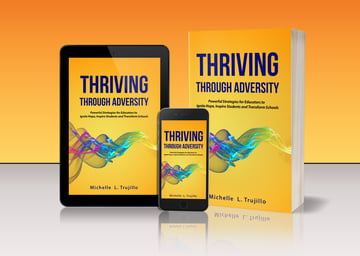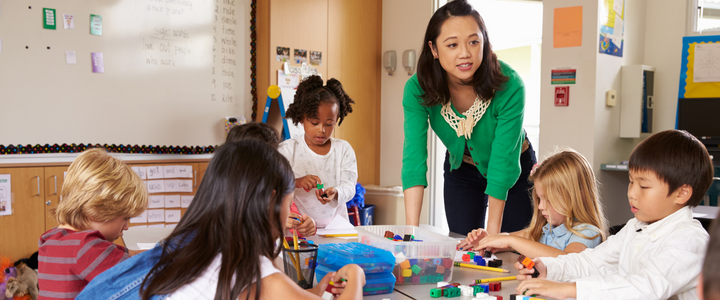A recent survey by the National Education Association (NEA) reveals that 55% of educators throughout the country report that they are planning on leaving the profession or retiring early. Amid the pandemic, a survey conducted by the Centers for Disease Control and Prevention (CDC), exposed that 37% of teachers self-reported symptoms consistent with anxiety disorder, 27% with clinical depression, while 19% disclosed that they started or increased alcohol use to deal with stress and emotions since the pandemic.
Today, educators across our nation are overwhelmed, under-resourced, and emotionally and physically exhausted. At the same time, the world has watched educators over the last two years as they have opened their minds and hearts to serve students, families, and each other with creativity, ingenuity, patience, flexibility, empathy, and wisdom. If you are an educator reading this blog, please hear me say thank you! Thank you for all you are and all you do as educators teaching and supporting the youth of our nation.
You realize that going to work every day is more than a job, it is a vocation — a calling that makes a difference in the lives of others. Yes, you’ve experienced challenges to teaching, learning, accessibility, and equity. You’ve covered for your colleagues when substitute teachers are unavailable, combatted the judgment from a small number of loud voices who have not walked in your shoes, and you’ve practiced patience with everchanging COVID protocols. You faced adversity and you’ve prevailed. Whether you recognize it or not, you have what it takes to thrive through adversity and to help your students do the same.
As a lifelong educator myself, I realize the reality that lives in the poll data from the NEA. I also know that hope is vital in the lives of our students, their families, our colleagues, and ourselves.
This is why I write to remind you: We are educators, and as educators, we are Ignitors of Hope! When we focus first and foremost on hope, we are more likely to encourage, engage and empower our students and their families.
Equally important, when we invest in our role as Ignitors of Hope our vocational purpose will be revitalized and our resiliency restored. As you consider the adversity you currently face, let me share with you five ways to ignite hope.
1: Renew Our WHY.
Simon Sinek, author of Start with Why (2009), suggests that we can know what we do, and even how to do it, but if we don’t know why we do what we do, it will lack meaning and purpose. We cannot lose sight of why we chose our vocations in the first place. Unfortunately, the truth of the matter is that many of us do.
Even prior to the pandemic, educators were expressing a sense of overwhelm and burnout. And now, the responsibilities of keeping people safe, following new protocols, addressing interrupted learning, covering classes, or adjusting schedules at a moment’s notice can overwhelm us so much that we can forget to “see” that which is right in front of us: the human beings with whom we interact every day; the young minds and hearts we serve and the colleagues with whom we share time and talents.
Simply being an educator, regardless of our role – teacher, principal, school counselor or social worker, paraprofessional, or support staff – provides us with an opportunity to ignite hope, in our own lives and in the lives of those with whom we work and teach. Irrespective of our subject area expertise, our value as a leader, or our instructional or support staff experience, if we neglect compassion for people and enthusiasm for education, we diminish our effectiveness.
Take a moment to think about why you chose the education vocation in the first place, and then share that reason with a colleague, student, or loved one. When we renew our why we ignite hope in our own hearts, and in doing so, we experience renewed passion, empowered purpose, and resiliency within adversity. Most importantly, we prepare ourselves to ignite hope for our students as we help them to discover their own why for learning and living with purpose.
2: Be Intentional.
Have you ever arrived at the end of your day and wondered how you got there so fast?
Often, when we have a great deal on our plates, as most educators do, we set ourselves on “go” and just take care of business. In the meantime, however, we miss things. More importantly, we miss people- and opportunities to connect with them!
There are many ways we can ignite hope by being more intentional, but I want to focus specifically on the importance of believing intentionally. Many of our students find it difficult to believe in themselves or their ability to achieve. Especially today, following interrupted learning, situational poverty, loss of stability, or loss of a loved one, our students have experienced challenges or trauma that may cause them to doubt themselves or their abilities.
Therefore, it is imperative that we believe with intentionality. According to John Hattie’s Visible Learning research (Hattie, 2019), the leading influence on student learning is Collective Teacher Efficacy. Collective Teacher Efficacy can be defined as the belief that we, as a body of educators, have in our students’ ability to achieve and the belief in our own ability to make an impact on their learning. We have seen our students excel when we recognize their strengths, believe in their ability to achieve, and cultivate their creativity.
As much as we all know that one person can make a positive difference, the power that comes from all members of a school staff collaborating, supporting, and encouraging each other and our students, makes an indelible impact on the entire school community.
Webster Dictionary defines hope as the “desire of some good, accompanied by the expectation of obtaining it or the belief that it is obtainable.” If the number one indicator of success for students is our collective belief in them and in ourselves, then we are and must be, Ignitors of Hope.
3. Seek to Understand.
At the beginning of the pandemic, COVID 19 was purported to be the great equalizer; I often heard people claim that we, as humans, were all in the same storm. An important reminder, however, is that though the storm may be the same, the boats in which we travel are often quite different.
As we consider the chaos that the storm of this pandemic has caused in the lives of our students, their families, and our colleagues, as well as the torrential impact of social unrest and racial injustice, we cannot assume that we know what others are experiencing. Instead, we must seek to understand. Ignitors of Hope see the story behind the student, the child behind the test score, and the human being behind the behavior. As educators, we are ultra-aware of the anxiety that our students feel about required state assessments, especially today when many students are being tested on content that they have not yet been taught.
In fact, we are aware of the anxiety we feel connected to said assessments. We are also aware that, nationwide, our students are experiencing increased mental health concerns, as well as situational trauma related to various events that have occurred over the past year. These experiences can result in chronic absenteeism, classroom discipline and disruption issues, and suspension or expulsion-associated behaviors.
We must remember that our students are children first. They are human beings seeking love, acceptance, and safety. Some of them are literally striving to merely survive each day.
David Osher, Vice President and Fellow of American Institutes for Research, suggests that as educators, we must ask ourselves if our students are thriving or simply surviving. In order for them to thrive, they need us to see them for who they are and meet them there, in the midst of their often-chaotic worlds.
When we acknowledge them as people first, looking beyond their performance or behaviors, to find the story behind the student, we will help to reduce anxiety, improve behavior, and ignite hope.
4. Lead with Love.
I realize that “love” may not qualify as the latest evidence-based research or new initiative in education, but it is vital that we consider it in the context of student achievement and growth.
According to Dr. David Osher, Vice-President and Fellow of American Institutes for Research, “We know from a great deal of research in neuroscience, biology- developmental and cognitive, that learning and development occur in relationally-rich environments; that loving relationships contribute to thriving while creating physiological, emotional, and cognitive readiness to learn.”[1] As such, if we, as educators, choose to approach all students, families, and our colleagues, from a place of love, we will foster empathy, acceptance, trust, self-efficacy, and responsiveness to high expectations and accountability.
Choosing to lead with love means that we refrain from making assumptions or judgments and that we take time for self-reflection, to assess our potential implicit or explicit biases. We lead with love when we listen actively, encourage others, express gratitude, set boundaries and. There is much that has been out of our control over the last year, making a choice to lead with love is not one of those things. Ultimately, to lead with love is to ignite hope.
5. Create Connection.
As educators, we know the importance and impact of positive relationships. Yet we often are caught up in all that we have to do and forget to purely be. Being connected to our students is the final way in which we can ignite hope and find our way out of vocational discouragement, uncertainty, or overwhelm.
Who we are and how we interact with the human beings within our school community can make an academically empowering and life-changing impact! Taking time each day to greet our students by name, as well as our colleagues, helps them to feel acknowledged and recognized. It doesn’t matter if it occurs in person or virtually, it only matters that it occurs! We also must remember the importance of smiling with our eyes and expressing our feelings with words, especially if we are wearing masks.
Though physical distance is a responsibility for all of us to practice during a pandemic, emotional and social connection is vital to our mental health. In fact, Shawn Achor, researcher and author of The Happiness Advantage (2010), states that, “When we make a positive social connection, the pleasure-inducing hormone oxytocin is released into our bloodstream, immediately reducing anxiety and improving concentration and focus.”
The powerful result of authentic connection positively impacts the person with whom we are connecting, but also alters our state of mind and being for the better. Humans need connection. When we connect, we ignite hope!
We must remember that we chose this profession for a reason. When we work with our colleagues to believe in our students and our impact on their learning, when we lead with love, seeking to understand our students and their families, and when we make a conscientious effort to connect, we ignite hope! And in hope, we rekindle the meaning and purpose of our vocation while inspiring and encouraging our colleagues and students.
We must never forget that we are educators, we are Ignitors of Hope, and we can thrive through adversity!
[1] Trujillo, Michelle L. Thriving through Adversity: Powerful Strategies to Ignite Hope, Inspire Students and Transform Schools. Center for Learning and Well-Being, 2021.

Ready to start thriving?
Michelle is offering a special promotion for our audience — save over 10% on her new book, Thriving Through Adversity: Powerful Strategies for Educators to Ignite Hope, Inspire Students, and Transform Schools, using this link!
Looking for more from Michelle?
Catch up on this episode of Teaching Channel Talks, where Michelle Trujillo and Wendy Amato discuss the lessons in Michelle’s new book, how to ignite hope in the moment, and move forward with intention.







